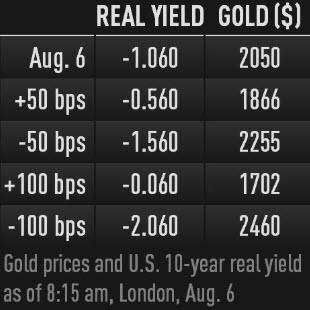Convexity Gives Gold Bulls One More Reason To Buy
Tyler Durden
Fri, 08/07/2020 – 13:15
By Ven Ram, currency and rates strategist for Bloomberg’s Markets Live
Gold already boasts several qualities that enhance its allure: a hedge against inflation, a haven asset, a friend in need. Add one more to the list: convexity.
When real rates decline, gold’s value tends to go up more than it declines when yields climb. That’s based on analysis of the metal’s duration, which measures percentage changes in reaction to a 1ppt shift in underlying interest rates, and convexity, which gauges the change in duration in response to yields.
To measure duration, I took into account the value of gold against real rates, as delineated by the path of linker bonds in the U.S., over the past decade. I then used interest-rate simulation to see how the metal would move in response
The analysis shows that the duration of gold is 17 when interest rates go up and 20 when yields trend lower, suggesting that the second derivative of the shift in rates is alive and kicking. Back in 2018, Pimco found a duration of almost 30.
If real interest rates shift 100 basis points lower from current levels, gold prices may approach $2,500 an ounce, while a similar move higher would send the metal to around $1,700.
Gold has been on a tear this year, having surged 35% in response to a 120-basis point slump in real interest rates. Other catalysts include low global yields; erosion of confidence in global fiat money in general and a weaker dollar in particular; unbridled global monetary and fiscal stimulus; investor purchases through exchange-traded funds in response to uncertainty about the evolution of the pandemic.
However, the outlook for gold gets murky once it goes to around $2,500 an ounce. Beyond that level, it would imply a massive plunge in real rates and an even sharper rally in breakevens than what we have already seen.
Correlations suggest these factors would also imply a big decline in nominal 10-year yields, which currently sit near 0.50%. Such a move would essentially mean the markets are pricing in a depression-like scenario. Should it play out, the study indicates gold may be propelled toward $3,000 should real yields slump to -3.15%.
Given that gold has a longer duration than linkers, the metal offers a balance sheet-economical way to hedge against inflation.
There are some limitations to note for the study. It looked at the behavior of gold just in the past decade, but the metal has a far longer history and its duration may change depending on the time frame. Meanwhile, the methodology used nominal gold prices. But given how anemic inflation has been in the past decade, it’s unlikely to have distorted the findings.
Also, while there are many factors that play into the price of gold, I studied the effect of only changes in real yields to isolate their impact.
All told, gold’s positive convexity means that investors’ gains will be amplified if real rates fall and their losses will be limited if rates rise. In an environment of heightened uncertainty, it’s about as close as they could get to a win-win scenario.
